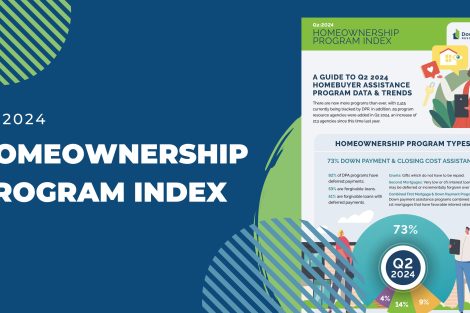
The Down Payment Resource Q2 2024 Homeownership Program Index Report

Owning a home has been shown to be one of the most effective ways Americans can build generational wealth.
Although equal access to housing is a civil right, systemic racism within housing finance institutions has kept communities of color from accessing equal housing opportunities. In fact, the gap between Black families who own a home and white families has persisted over the years and is widening. In 1976, 69% of white families owned a home, while 44% of Black families owned a home, a gap of 25%. In 2022, 75% of white families owned homes, while 45% of Black families owned a home, a gap of more than 30%.
LendingTree recently analyzed U.S. Census Bureau data to analyze racial homeownership demographics in the nation’s 50 largest metropolitan areas. The study found while Black people made up an average of 15% of the population across the metros, only 10% of homes were owned by Black homeowners. For comparison, white people across the same metros accounted for an average of 58% of the population, yet owned an average of 69% of owner-occupied houses.
Many factors contribute to this disparity and make the racial ownership gap difficult to close.
First, the average income for Black households is lower than for white households. According to Census Bureau numbers, the median income for Black households in 2023 was $52,860. That’s more than $28,000 less than the $81,060 median income for white households.
Plus, less of that income is considered to be disposable. According to the National Association of Realtors, Black homeowners spend more of their income to own their homes than all racial groups, with 30% being cost-burdened, meaning they spend more than 30% of their income on housing. If they’re paying rent, that money is going into their landlords’ pocket rather than if they were paying a mortgage and building equity through homeownership. Black Americans also are more likely to be unbanked.
These factors make it difficult for Black and other minority homebuyers to qualify for a mortgage. In 2022, Black and Hispanic applicants experienced denial rates of 16.4% and 11.1% respectively, while the denial rate for white applicants was 5.8%.
The good news is there are many loan programs that can help increase Black homeownership.
For starters, there are lending programs for low-income homebuyers with low down payment requirements, such as FHA mortgages, which typically require 3.5% down, and VA and USDA mortgages, which can require as little as zero down.
Homebuyers should always “shop around” for a mortgage to find the best terms. A Fannie Mae study found one-third of recent homebuyers get a single mortgage quote in spite of having online resources for finding multiple lenders and comparing quotes. By comparing offers from different lenders, homebuyers can select the offer with the best rate and fees, making their purchase more affordable.
Finally, homebuyers should learn about down payment assistance (DPA) programs in your area and be sure to apply for DPA early in the buying process (your real estate agent or lender can help or search our online database). This is especially important for low-income and minority buyers. A 2023 poll by Keybank of 1,000 homeowners who earned less than $75,000 annually found nearly one-third (31%) did not seek out any information or resources on homebuyer assistance programs.
Having more money for the down payment or other mortgage costs could make a huge difference. Down Payment Resource partnered with Urban Institute to look at loan activity in the nation’s top 10 metros. The study found that DPA could have potentially salvaged the loans of about 46,000 denied applicants (30.7%) since it would have lowered the loan amount for a more favorable debt-to-income ratio (DTI) or provided cash to meet the necessary cash-to-close (CTC) requirement.
Down Payment Resource recently reexamined the study data to look at homebuyer assistance program eligibility by race. We found that 54.7% of Black homeowners could have been eligible for homebuyer assistance. Breaking this down by loan type, 79.8% of Black homebuyers financing with FHA loans would have been eligible for DPA. Notably, the number of homebuyers eligible for DPA is substantially higher than those who used a form of DPA to finance their homes. This gap in DPA use affects a significant number of Black homebuyers who could have saved tens of thousands of dollars on buying a home, and Black mortgage applicants who could have been approved with DPA.
This Black History Month, let’s honor the legacy of resilience and strength within the Black community by championing a path to homeownership for more Black families.
After all, homeownership isn’t just about owning property; it’s about securing a foundation for generational wealth, stability and pride. Let’s also recognize the importance of economic empowerment. By owning homes, Black families can break barriers, build equity and shape their own future.
Down Payment Resource has crafted tools to help mortgage lenders, real estate agents and multiple listing services build relationships with homebuyers by connecting them with the homebuyer assistance they desire.
To explore the best option for your business, contact us.
